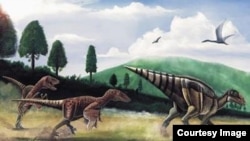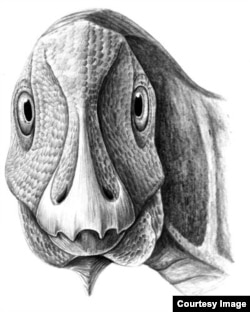Millions of years ago in what is now the central Romanian region of Transylvania, a dwarf dinosaur walked the earth with a non-cancerous facial tumor similar to those found today in humans, other mammals and some reptiles.
The fossilized jaw of a Telmatosaurus transsylvanicus, a “type of primitive duck-billed dinosaur known as a hadrosaur,” was recently unearthed by researchers at the University of Southampton and is the first time a tumor has been discovered in a fossilized dinosaur.
“This discovery is the first ever described in the fossil record and the first to be thoroughly documented in a dwarf dinosaur,” Kate Acheson, a PhD student at the University of Southampton. “Telmatosaurus is known to be close to the root of the duck-billed dinosaur family tree, and the presence of such a deformity early in their evolution provides us with further evidence that the duck-billed dinosaurs were more prone to tumors than other dinosaurs.”
The Telmatosaurus lived some 67-69 million years ago and was found in what is called the “Valley of the dinosaurs" in the Haţeg County Dinosaurs Geopark in Transylvania, western Romania, also a UNESCO site.
“It was obvious that the fossil was deformed when it was found more than a decade ago but what caused the outgrowth remained unclear until now,” says Dr Zoltán Csiki-Sava of the University of Bucharest, Romania, who was involved in finding the fossil. “In order to investigate the outgrowth, our team was invited by SCANCO Medical AG in Switzerland to use their Micro-CT scanning facilities and to ‘peek’ un-intrusively inside the peculiar Telmatosaurus jawbone.”
The tumor is known as a ameloblastoma, a benign growth that is found in the jaws of humans and other animals and reptiles.
Researchers say the dinosaur likely did not suffer any pain during the early stages of the tumor, but it died before being fully grown, and researchers are unsure if the tumor contributed to the creature’s death.
“We know from modern examples that predators often attack a member of the herd that looks a little different or is even slightly disabled by a disease. The tumor in this dinosaur had not developed to its full extent at the moment it died, but it could have indirectly contributed to its early demise,” said Csiki-Sava.











